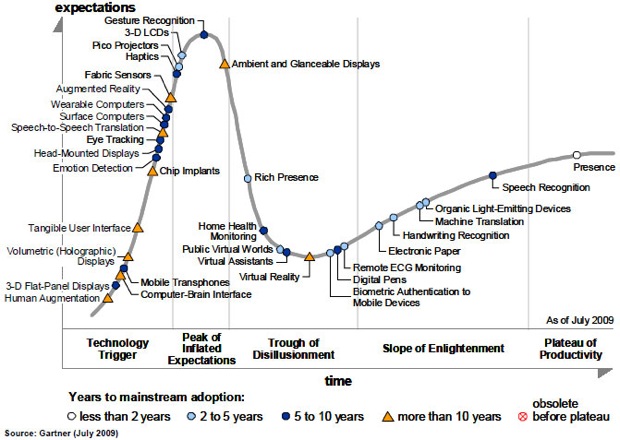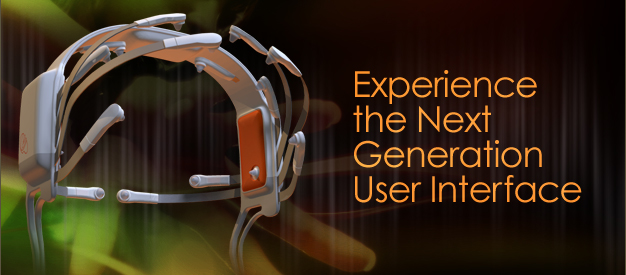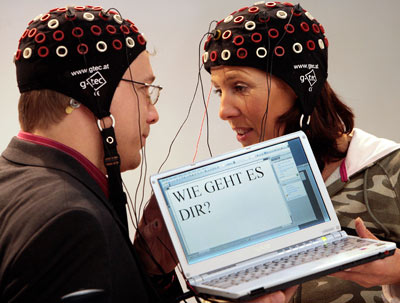Archive for the ‘Brain-Computer Interface’ Category
Do You Twitter, just by Thinking About it?
Tuesday, April 28th, 2009 On April 1st, Adam Wilson, a doctoral student at the University Of Wisconsin at Madison was the first person to post an entry on Twitter (“using EEG to send tweet”) via a brain-machine interface. You can see a video of how it works on NITRO lablog or check the original (with some interesting follow up tweets) here.
On April 1st, Adam Wilson, a doctoral student at the University Of Wisconsin at Madison was the first person to post an entry on Twitter (“using EEG to send tweet”) via a brain-machine interface. You can see a video of how it works on NITRO lablog or check the original (with some interesting follow up tweets) here.
Thanks at Max Clare at BSU for sending this news item.
CES is a Hotbed of Advanced Design
Thursday, January 8th, 2009 About 20,000 new products will be announced at this year’s International Consumer Electronics Show (CES) that is kicking off in Las Vegas today. It is usually a hotbed of innovation and gadgets with special features and functions to delight our senses (sensorial design) and stimulate our thoughts and feelings (cognitive design).
About 20,000 new products will be announced at this year’s International Consumer Electronics Show (CES) that is kicking off in Las Vegas today. It is usually a hotbed of innovation and gadgets with special features and functions to delight our senses (sensorial design) and stimulate our thoughts and feelings (cognitive design).
The announcement for the Mind Flex Game caught my eye.
Thought-Recognition Technology on 60 Minutes
Tuesday, January 6th, 200960 Minutes has a great story, How Technology May Soon “Read” Your Mind, covering the latest work in thought-recognition technology.
 “As Lesley Stahl reports, neuroscience research into how we think and what we’re thinking is advancing at a stunning rate, making it possible for the first time in human history to peer directly into the brain to read out the physical make-up of our thoughts, some would say to read our minds.”
“As Lesley Stahl reports, neuroscience research into how we think and what we’re thinking is advancing at a stunning rate, making it possible for the first time in human history to peer directly into the brain to read out the physical make-up of our thoughts, some would say to read our minds.”
Next Generation User Interface: Your Thoughts!
Thursday, December 18th, 2008 Earlier this year I reserved a couple of EmotivEPOC systems, the world’s first brain-computer interface built for consumer use. If the technology works reliably we will have an important new tool for cognitive design. The system is both a platform for developing products that directly incorporate cognition as well as a modeling tool for uncovering how people are thinking and feeling under a variety of conditions.
Earlier this year I reserved a couple of EmotivEPOC systems, the world’s first brain-computer interface built for consumer use. If the technology works reliably we will have an important new tool for cognitive design. The system is both a platform for developing products that directly incorporate cognition as well as a modeling tool for uncovering how people are thinking and feeling under a variety of conditions.
I was hoping to have them for Christmas but that seems unlikely. Working with students I already have a pipeline of product designs to prototype and experiments to run.
I did find an interesting in-depth article on the company, technology and founders in Inc. magazine titled Reality Bites. Tech giants, IBM and Intel, are eyeing the technology.
”Some powerful partners have come on board. IBM (NYSE:IBM) is working with Emotiv to develop a corporate version of the headset that would allow, for example, virtual conferencing with avatars that represent people’s expressions and feelings — so you would know who was engaged, who was bored, who was laughing at your jokes, and, maybe, who was pretending to laugh.”
Measuring EEG in Virtual Reality to Test Designs
Monday, December 15th, 2008 Imagine being able to measure the cognitive impact of a workspace or building design before you built it. A group of architects and academic researchers is doing just that in California as they monitor the brainwaves (EEG) of users as they interact with a proposed design in a virtual reality (VR) environment.
Imagine being able to measure the cognitive impact of a workspace or building design before you built it. A group of architects and academic researchers is doing just that in California as they monitor the brainwaves (EEG) of users as they interact with a proposed design in a virtual reality (VR) environment.
 Not only do they expect to avoid costly design errors, make way-finding easier and otherwise optimize designs for how our minds work but they expect to gain scientific insight into how we form “cognitive maps” as we navigate. This is doing cognitive design and some applied cognitive science at the same time.
Not only do they expect to avoid costly design errors, make way-finding easier and otherwise optimize designs for how our minds work but they expect to gain scientific insight into how we form “cognitive maps” as we navigate. This is doing cognitive design and some applied cognitive science at the same time.
The project is described well in a post on MSNBC, Get Lost and Get Better Architecture. The end of the article is most interesting to cognitive designers. Berns a Neuroscientist at Emory University speculates that ”the relative mobility of EEG technology could lend itself to poring over the brain waves of people in existing buildings as well”. This might open up a new level of rigor for the cognitive design of spaces.
Plugging into the Brain
Friday, November 14th, 2008Almost two weeks ago I did a post on harnessing brainpower, a report by 60 Minutes on brain-machine interfaces. Now brain-machine interfaces are on the cover of Scientific American magazine.
The lead story, Jacking into the Brain, covers the expected ground but does have some interesting speculation about the future including the possibility of converting text into neural signals for downloading into our brains.
Harnessing Brainpower
Monday, November 3rd, 200860 Minutes has an excellent report (including video) on the latest use of brain-machine interfaces to help the disabled to move wheelchairs, write emails and operate computers with thought alone.
Extreme Cognitive Design Meets Road Rage
Friday, October 17th, 2008The Discovery Channel’s Prototype This! team used biofeedback and mind control systems to prototype a car that safely slows and even stops as the driver becomes angry.
If you have 40 minutes watch the full episode of the Mind Controlled Car. It is worth it! Or if you just have a few minutes check out this 3 min video on final testing.
Army Gives $4M Grant for Synthetic Telepathy
Tuesday, October 14th, 2008Michael D’Zmura the chair of cognitive sciences at the University of California at Irvine reports landing a $4M grant to develop an advanced brain computer interface for the Army. According to the press release:
“The brain-computer interface would use a noninvasive brain imaging technology like electroencephalography to let people communicate thoughts to each other. For example, a soldier would “think” a message to be transmitted and a computer-based speech recognition system would decode the EEG signals. The decoded thoughts, in essence translated brain waves, are transmitted using a system that points in the direction of the intended target.”
Talk about designing for how minds work!
Spin-out applications are years away but this shows seriousness about continuing to develop the technology.
[Two people writing "how are you?"]
The discovery channel has covered the UC Irvine grant as the news story, Helmet to Convey Messages by Thought.
Connecting this to the items I blogged earlier on Brainwave Binoculars (that interface with the solider’s brain) we get a glimpse of how far the military is taking the disciplines of cognitive engineering and design.





